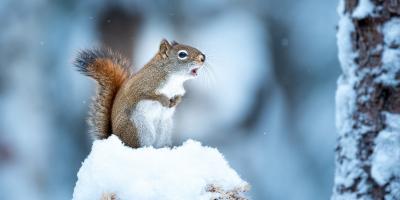Cotton Candy Squirrels: Fantasy or Reality?

You’ve probably heard of the Pink Panther and Pink Floyd, but do you know what’s even prettier in pink? Pink flying squirrels.
Okay, so the squirrels themselves aren’t exactly pink, but like something out of a Dark Side of the Moon laser-light show, you can turn their fur pink by shining an ultraviolet (or UV) light (also known as a “blacklight”) on them. And that goes for all three of the species of squirrel found in North America.
A Pink Puzzle
If you’re scratching your head wondering why flying squirrels would need to fluoresce pink in the first place, you’re not the only one. Scientists are still puzzled and do not know if flying squirrels in other parts of the world also turn pink under UV light -- no one has tested it out yet.
But if you’re shocked to discover that flying squirrels fluoresce, just wait until you get a load of these puffins.
A research student set out to see if puffin feathers glow under blacklight, only to discover something far more festive -- under UV light, puffin’s beaks light up like Christmas. Unfortunately, however, this was discovered using a dead puffin, but scientists are working on testing whether live puffins also have glowing beaks. But first they had to design some UV-blocking eyewear for the little birds, so the light doesn’t damage their corneas.
More Day-Glo Discoveries
Some animals glow from the inside out. At least color-changing chameleons do. They glow under UV light, but it’s not their scales, it’s their bones lighting them up. About 75 percent of deep-sea creatures light up under blacklight, so it’s no real surprise that chameleons, which are lizards, are only one evolutionary step away from sea creatures.
Okay, to discover another animal that glows in the dark (under UV light), here’s a riddle: Who hunts at night, who glows in the dark and who makes a sound like a word repeated thrice in this sentence? The northern saw-whet owl, that’s who. Much like flying squirrels, the feathers on the underside of this nocturnal bird’s wings glow a bright pink when exposed to a blacklight and, like with those squirrels, scientists are still bewildered as to why.
But it’s not just northern saw-whet owls, barred owls glow, too. However, even stranger than that is how owls exhibit varying degrees of luminosity not just from species to species but in individuals as well. Some light up brightly while others have just a faint glow and scientists are stumped trying to figure out what makes one owl outshine another.
If nothing else, the recent discovery that certain species of animals have glow-in-the dark traits, shows how much we still have to learn about the creatures who share our world. Scientists are constantly learning more, and it’s our job to keep up with these recent findings and how they may apply to our pest control techniques. That way, we can keep providing the best, most current methods and products based on what entomologists currently know about the target pests.



